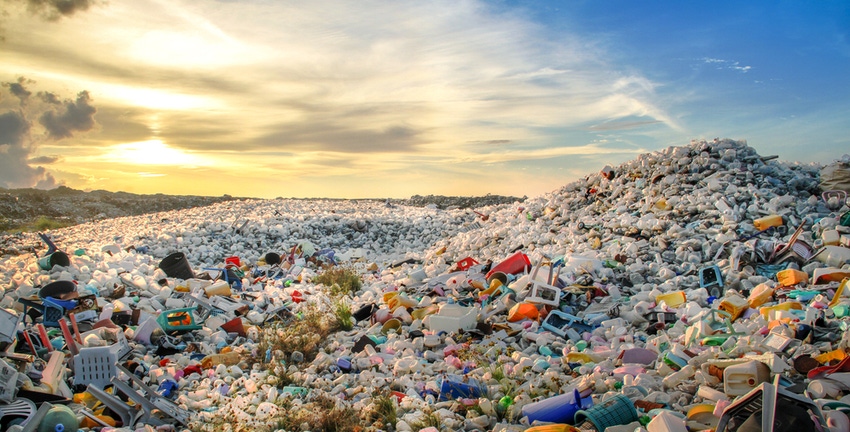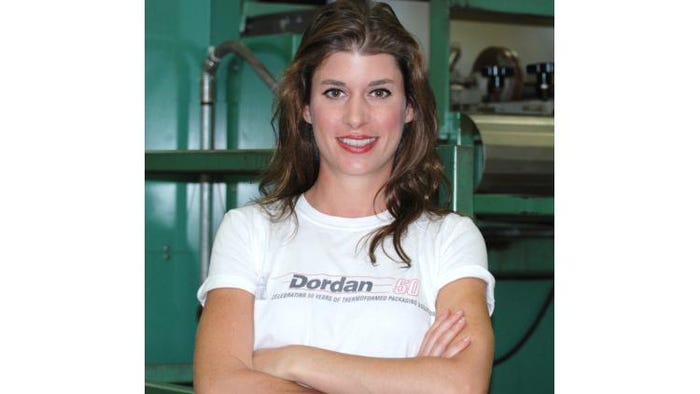
An environmentalist and a plastics representative walk into a bar. The environmentalist says, “Plastic is killing the planet.” The plastics representative responds, “But plastics save resources by being so efficient!” They roll their eyes at one another and sit at opposite ends of the bar. And so continues the Great Plastics Divide.
Can the differences ever be reconciled? Let’s look at each perspective and, yes, some possible solutions.
Plastic has long been targeted as demonstrative of our throwaway society, our culture of excess, of waste. This image of plastics is so prevalent that you see it in contemporary art. Brooklyn-based artist Dana Bell recently thermoformed bio-plastic art as critique of our contemporary modes of production and consumption. Her project abstract reads:
“My newest body of work is based on the problems of production found in fast fashion, limited-use furnishings/decor, and commercial packaging. Using the very tools, materials and techniques behind the modalities of mass production, I am creating sculptures, paintings, and photographs. In doing so, I seek to develop a body of work which speaks in critical dialogue with over-production, over-consumption, and the disposable desire that holds accumulative manufacture together, and propels the system of proliferating waste…By re-contextualizing the materiality of waste and industrial byproducts and transforming the detritus into intentional art objects, I aim to focus attention upon, and to denormalize escalating waste culture.”

Dana Bell’s algae-plastic thermoformed art looks to challenge our “waste culture” by using the very technologies of mass production to create decomposing art. Material provided by Dordan via ALGIX LLC.
But #plasticsmakeitpossible proponents tweet alongside stories of how plastic packaging protects food the longest, reducing spoilage. Natural capital accounting firm TruCost supports these arguments, finding that plastics are in fact the preferable environmental material when compared with alternatives intended to perform the same function.
But when has science ever trumped public perspective? Take the plastic shopping bag—a waterproof, durable, lightweight packet capable of holding more than a thousand pounds its weight, soon to become a relic of modern convenience, thanks to bag bans aimed at its eradication.
Thus, plastics making it possible doesn’t replace the powerful images of albatrosses with plastic debris in their decaying stomachs, or children in India sifting through mounds of plastic garbage; it doesn’t change the economics of recycling, where much post-consumer plastic is of too little value to recover; and it doesn’t help position the industry toward a sustainable future where plastics is regarded as the true engineering marvel it is, not the environmental burden it is perceived to be.
Some argue that plastic isn’t the problem: people, policy and/or waste management schemes are. If we facilitate more recycling at the municipal level, and encourage the responsible disposal of plastic at the behavioral level, through education, incentives and investment in the recovery infrastructure, then we won’t see plastics in our waterways or landfills.
These remedies to the problem of plastic waste, though helping to move the needle, are too granular. Even if all of the best practices were sophistically implemented, it would not fundamentally change the public’s perception of plastic, because it would not solve the global problem of plastic waste.
What is the solution then?
The solution to the war of plastic ideologies becomes clear. The sociological construction of plastics as symbolic of waste culture—communicated through Bell’s art—will only be replaced with proper representation, when the global problem of plastic waste is tackled. Perception is power, and the perception of plastic can’t oscillate between good and evil, but fall on the truth.
The economy of waste is not divorced from capitalism. In the majority of America, waste management is funded by taxes and managed by municipalities. In countries with Extended Producer Responsibility programs, however, industry funds waste management and private companies compete for the management of the waste. America’s plastic recycling rates have stagnated while countries with EPR boast high plastic recovery and recycling rates. Economics and policy therefore dictate the success of waste management.
But it’s not as simple as who pays or how it’s managed when we are talking about eradicating global plastic waste.
Years ago I wanted the thermoformed packaging that Dordan makes to be recycled. I didn’t understand why, if it was made from recycled water bottles, it couldn’t be recycled with plastic water bottles. I wasn’t alone.
The price for virgin plastics was high, there was more capacity and demand for recycled polyethylene terephthalate (rPET) than supply, and Walmart released its infamous “Packaging Scorecard.” Industry alliances, recyclers, brand owners, producers and non-profits all championed for the recovery of thermoformed plastic packaging. The argument was PET thermoformed packaging could and would be recycled post-consumer if: (1) there was enough quality and quantity in the post-consumer waste stream to economically justify the collection and reprocessing of it; (2) it could be efficiently and affordably sorted at the recycling facility from look-alike containers, like polyvinyl chloride (PVC) clamshells; (3) it wouldn’t contaminate the existing PET water bottle recycling stream; and (4) there was a sustainable and consistent demand for the recyclate.
Thanks to the hard work of a lot of people, all the moving pieces came together, and it was reported in 2012 by Moore Recycling Associates that PET thermoformed containers are now “recyclable” insofar as the majority of American communities have access to facilities that can reprocess the material.
What’s the recycling rate of PET thermoformed containers today? Not terribly impressive. That’s because the cost of virgin plastics dropped, the reprocessing was found to be challenging, and the economics and initiatives that catalyzed the collection and recovery mostly disintegrated.
This story provides a snap shot into the complexities of the economics of recycling plastic packaging in North America.
The recycling market is in a constant state of flux depending on an array of factors that continuously ebb and flow. Countries with EPR, hands down, are the most proficient at recovering waste, but that is because of fundamental differences in consumer attitudes and governmental structure and funding. If the majority of ocean debris comes from the same four countries in the southern pacific that lack basic waste management infrastructure, then it is extremely doubtful that said countries can fundamentally change their culture and politics to implement EPR to stop the leakage of plastics into the oceans.
What is changing now?
The New Plastics Economy is a global initiative looking to eliminate plastic waste through innovation and collaboration. Spearheaded by the Ellen MacArthur Foundation and joined by an impressive alliance of companies, philanthropists, governments and non-government organizations (NGOs), the NPE is a concept rooted in a 2016 report by the World Economic Forum and the Ellen MacArthur Foundation, with analytical support from McKinsey & Co. Titled The New Plastics Economy—Rethinking the future of plastics, the report provides the vision of a global economy in which plastic never becomes waste.
The report illustrates a disconnect between the value of the plastic packaging we produce and use and its associated value after use. Because there is little post-consumer value associated with much plastic packaging, there is little economic impetus to collect and recycle it. Thus, the majority of plastic packaging remains outside the circular economy model, making its way into the natural environment and persisting in our waterways and oceans.
Susan Freinkel’s 2011 “Plastics: A Toxic Love Story” was ahead of its time. In it she notes this inherent economic disconnect of plastic. She writes,
“We are burying the same kinds of energy-dense molecules we spend a fortune to pump from the ground, scrap from mines, and blast mountaintops to reach. When we put these previous molecules into products we designed for the briefest of uses, we inevitably lose sight of their worth. We forget that an item like a used soda bottle is an item worth saving, not trash to be thrown away.”
Art is a barometer of society, its manifestations are glimpses into the cultural imaginations of a time and place. The sociological construction of plastics as representative of waste culture can be replaced, but it requires changing the economics of plastics such that plastics never become waste.
Instead of those in the industry inadvertently taking to the defense of plastics by focusing only on its success stories, all should acknowledge the global problem of plastics pollution, and learn intimately of the initiatives underway. Knowledge is more powerful than perspective when spread eagerly, so lets use our media platforms to share the new plastics economy initiative. On the vehicle of an informed populous, the opposing ideologies of plastics can finally come together, and toast to the sustainment of both the industry and the planet.
Let’s rally together behind the new plastics economy, because no one wants to drink alone.

Chandler Slavin is the sustainability coordinator and marketing manager at custom thermoforming company Dordan Manufacturing. Privately held and family owned and operated since 1962, Dordan is an engineering-based designer and manufacturer of plastic clamshells, blisters, trays and thermoformed components. Follow Slavin on Twitter @DordanMfg.
********************************************************************************************
Learn what it takes to innovate in the packaging space at MinnPack 2017 (Nov. 8-9; Minneapolis). Register today!
About the Author(s)
You May Also Like




